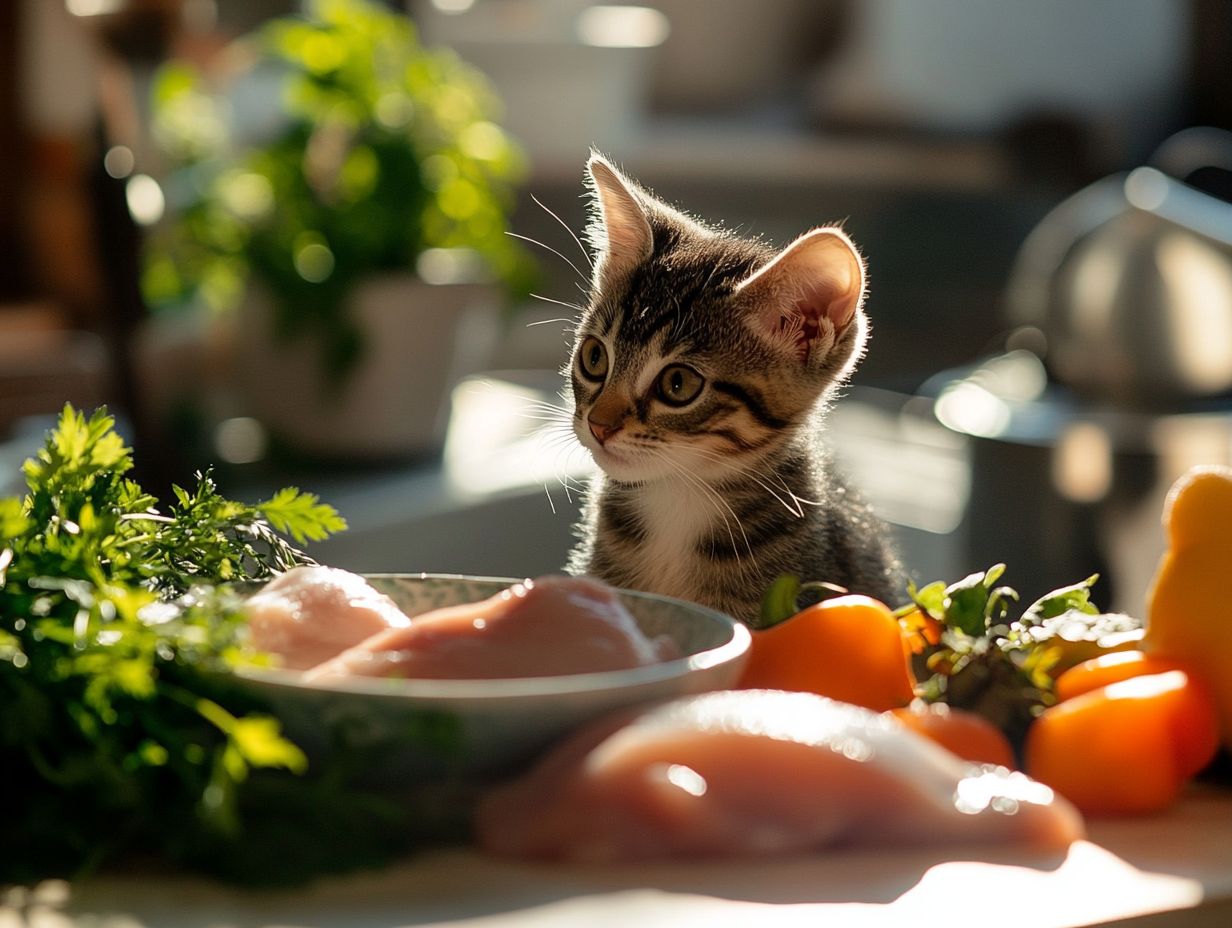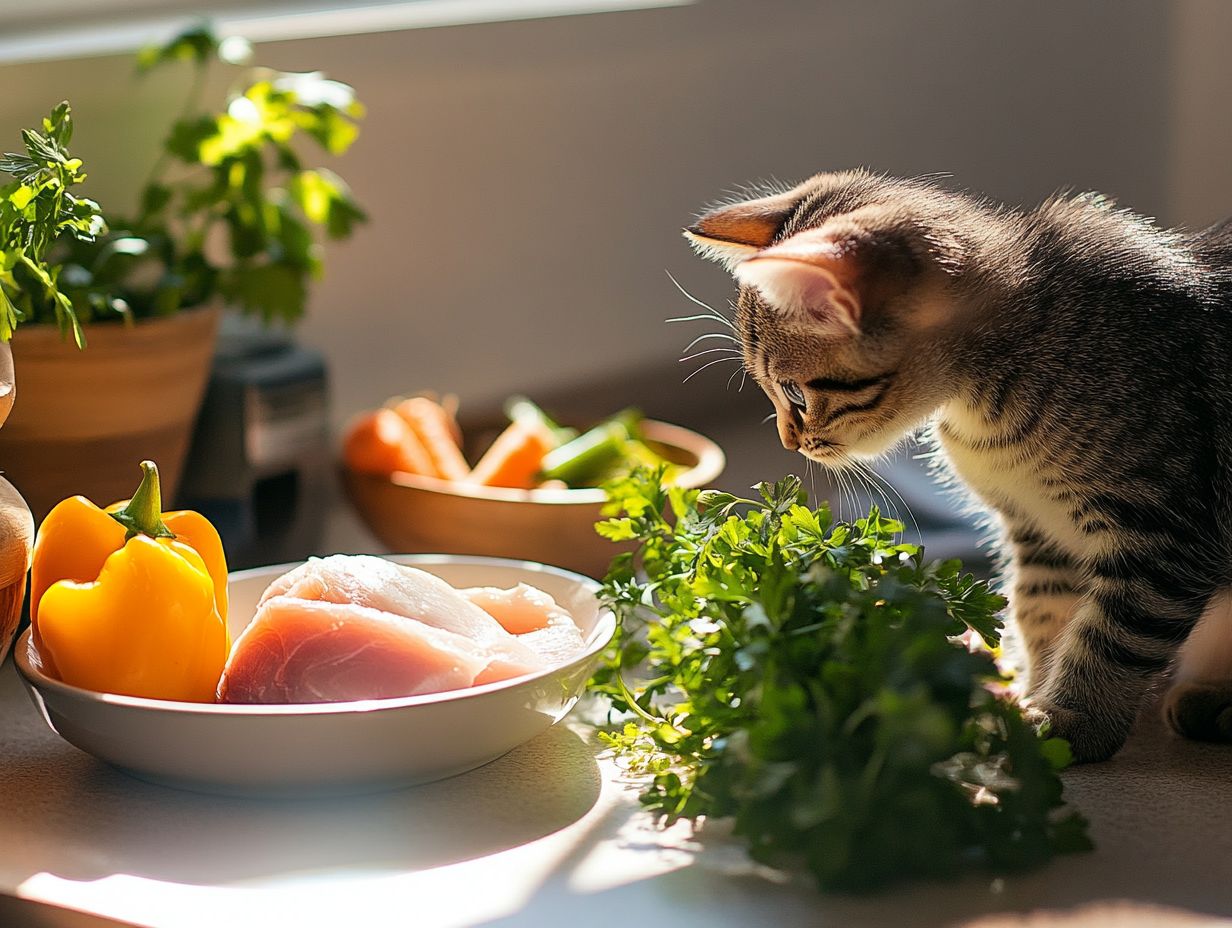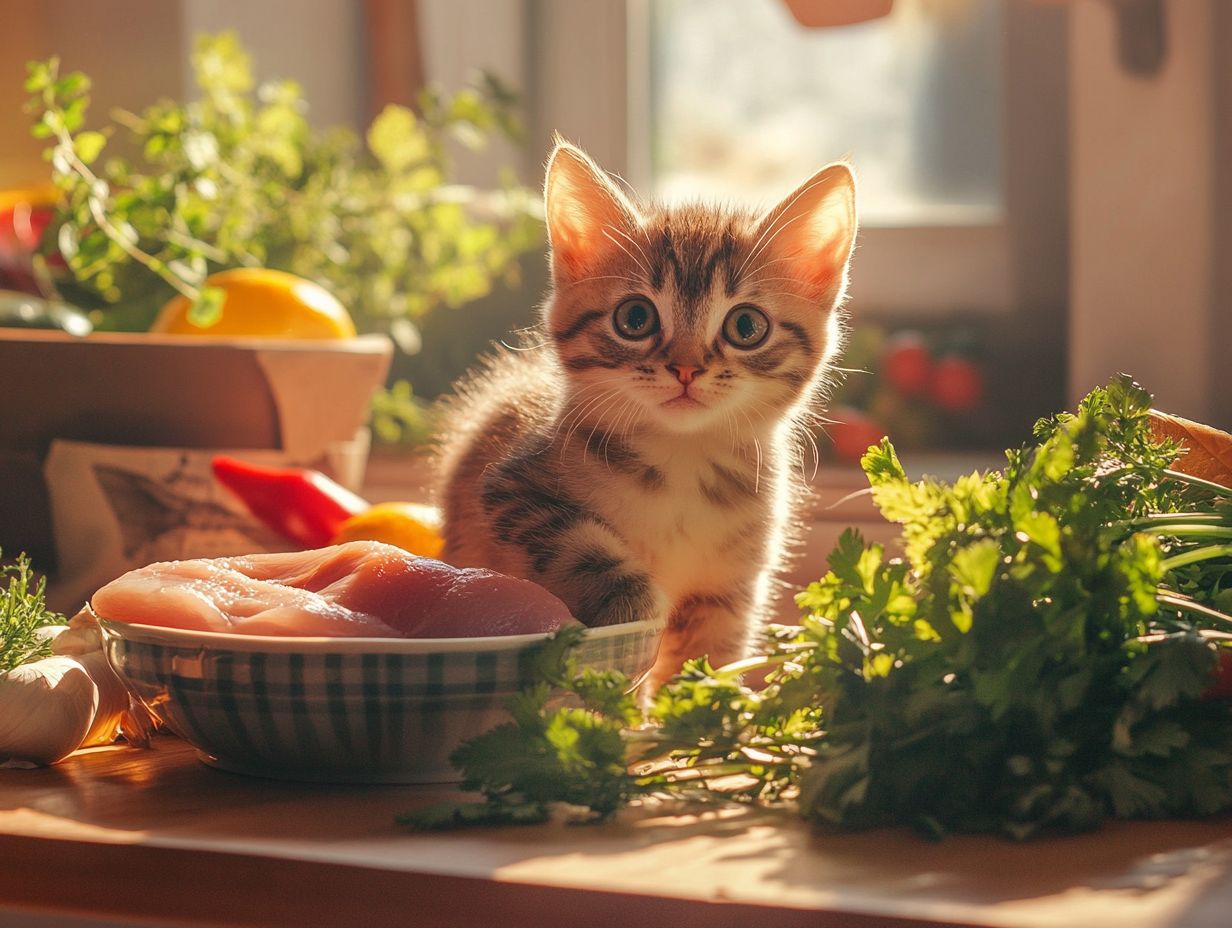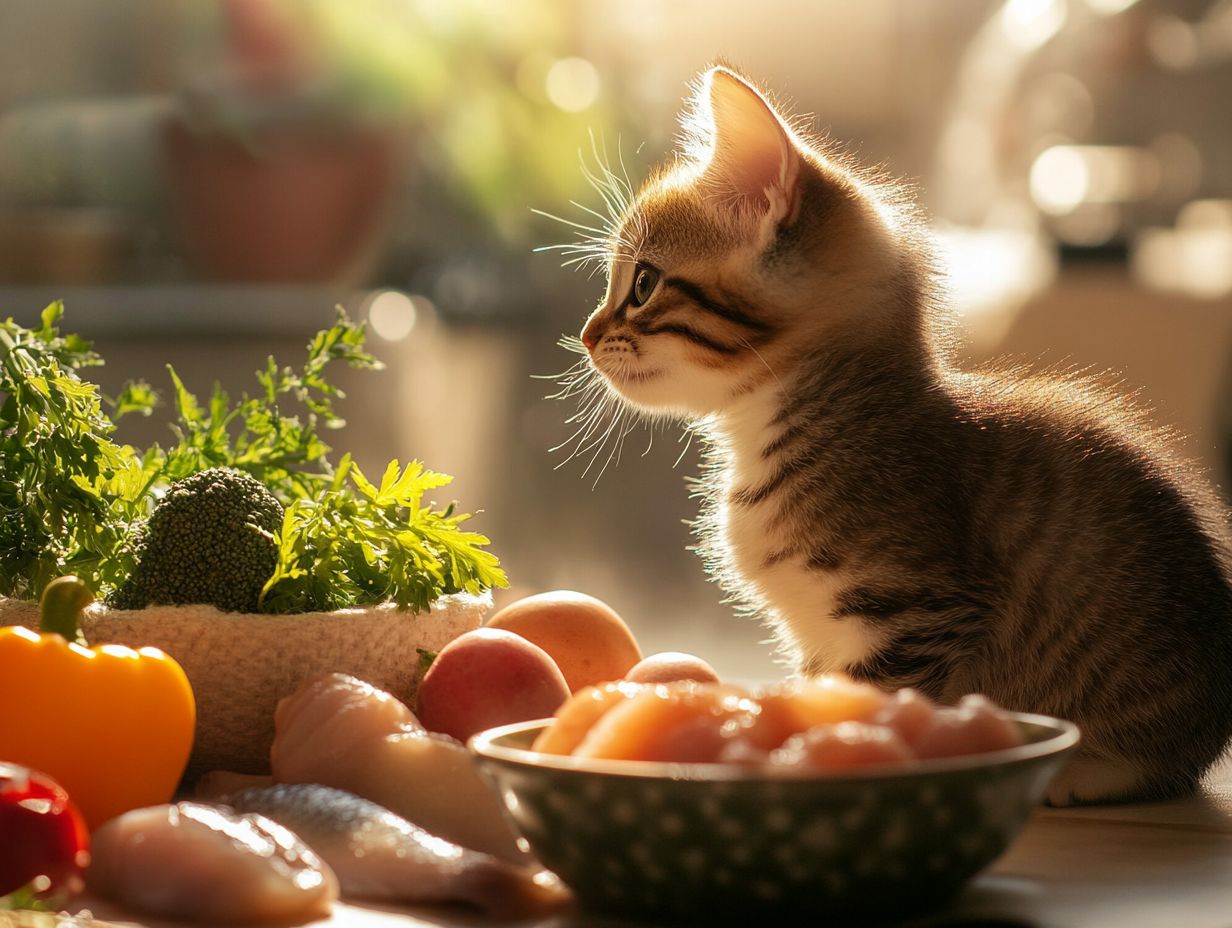A raw food diet is a controversial approach that requires careful consideration, particularly for your growing kitten. While it offers health benefits that traditional diets often lack—such as addressing obesity and nutrient imbalances—it is essential to approach this diet with balanced awareness of its risks and benefits. Consulting with a veterinarian is crucial, especially if your kitten has underlying health conditions.
The right raw food choices can provide essential nutrition, adhering to AAFCO guidelines for nutritional adequacy, promoting healthy growth, and boosting your kitten’s immune system.
This article explores the essentials of a raw food diet for kittens, including:
- What to include
- What to avoid
- Crucial safety tips to ensure your furry friend thrives
Discover how the right nutrition can make all the difference! Always consult a veterinarian before transitioning your kitten to a raw food diet, especially if they have health issues.
Key Takeaways:

- A raw food diet can provide complete and balanced nutrition for kittens, supporting their healthy growth and development, but must adhere to AAFCO guidelines to ensure safety.
- It boosts their immune system and promotes dental health while including high-quality proteins, essential vitamins and minerals, and healthy fats.
- However, certain foods should be avoided, such as raw fish, bones, and dairy products, due to potential health risks like bacterial contamination and choking hazards. Always consult with a vet and handle and prepare food properly to ensure safety.
Why is a Raw Food Diet Beneficial for Kittens?
A raw food diet offers complete and balanced nutrition tailored to the specific dietary needs of kittens, closely resembling the natural eating behavior of cats in the wild. This diet features high-quality animal protein and adequate moisture, both vital for maintaining healthy digestive function.
Additionally, a raw food diet meets the specific taurine requirements necessary for optimal growth and development, as emphasized by the Feline Nutrition Foundation. By choosing this diet, pet owners can mitigate health issues associated with commercial processed foods, which may lack important nutrients and contribute to conditions like kidney disease.
1. Provides Complete and Balanced Nutrition
A raw food diet ensures kittens receive a healthy intake of essential nutrients necessary for their growth. A focus on nutritional adequacy is crucial for developing bodies.
High-quality proteins like chicken, turkey, and fish provide essential amino acids, promoting muscle development and overall vitality. Additionally, this diet typically contains a higher percentage of moisture compared to dry kibble, aiding in digestive health and hydration. This aligns with feeding guidelines for optimal feline nutrition.
It is vital that these raw diets—whether homemade or commercial—adhere to AAFCO guidelines to guarantee they provide optimal benefits for kittens, allowing them to thrive.
2. Supports Healthy Growth and Development
A proper raw food diet promotes healthy growth by providing essential animal protein and meeting taurine needs, which is crucial for cognitive function during a kitten’s formative months.
High-quality raw food contains vital nutrients that prevent developmental delays and health issues, such as stunted growth and behavioral problems. Therefore, a balanced diet is essential for kittens to grow into healthy, active adults.
3. Boosts Immune System
A raw food diet enhances kittens’ immune systems by providing essential vitamins and minerals. This diet is rich in probiotics and immune-supportive nutrients that promote digestive health.
Veterinary nutritionists recommend natural sources like fermented foods and fresh, unprocessed ingredients, which are abundant in beneficial bacteria, maintaining healthy gut flora and supporting immune function.
4. Promotes Dental Health
A raw food diet benefits kittens’ dental health through the natural chewing action involved, along with softer proteins. This action helps in the mechanical removal of plaque and stimulates the gums, essential for maintaining overall dental hygiene.
Risks of Raw Diets
Despite the benefits, risks such as bacterial contamination and nutritional imbalances exist. Proper storage, handling, and preparation are vital to minimize these risks.
Alternative Diets
For owners hesitant about raw feeding, high-quality commercial cat food or prescription diets tailored to specific health needs can be excellent alternatives.
Always monitor your kitten’s weight and health with any dietary changes, and consult your veterinarian for personalized guidance. Introduce new foods gradually and watch for any allergic reactions to make informed decisions for your kitten’s health.
Disclaimer: Before making significant dietary changes for your kitten, particularly when considering a raw food diet, consult with a veterinarian to ensure the diet meets your kitten’s specific nutritional needs.
Raw food typically has a higher moisture content than processed options, helping to alleviate dryness and irritation in the mouth. Proper moisture levels are crucial, as many health issues related to dental problems arise from poor oral hygiene, leading to harmful bacteria.
Incorporating raw food into kittens’ diets can promote stronger teeth and gums, establishing a foundation for long-term dental health.
What Should a Raw Food Diet for Kittens Include?

A raw food diet should include high-quality protein sources, essential vitamins and minerals, healthy fats, and limited carbohydrates for a well-rounded nutritional profile. This approach aligns with guidelines from veterinary organizations like AAFCO and WSAVA.
1. High-Quality Protein Sources
High-quality protein sources are essential, providing necessary nutrients for proper growth and development. It is advisable to prioritize animal protein, which is generally more complete than plant proteins.
Chicken, turkey, and fish are rich in amino acids that support bodily functions, including muscle development. Selecting protein sources that comply with AAFCO standards is crucial for kittens’ optimal health and vitality.
2. Essential Vitamins and Minerals
Essential vitamins and minerals are crucial, supporting growth, development, immune function, and cognitive abilities. For instance, vitamin A is vital for vision, while vitamin D aids in proper calcium absorption.
Minerals like calcium and phosphorus promote strong bones, making natural sources, such as raw meaty bones, beneficial. The moisture content is also vital for digestion and nutrient absorption.
Following feeding guidelines ensures a balanced mix of these nutrients, contributing to overall health. Monitor for potential nutritional deficiencies in growing kittens.
3. Healthy Fats
Healthy fats are crucial, contributing to energy and supporting kitten growth. Omega-3 and omega-6 fatty acids are essential for brain health and maintaining a shiny coat.
Sources like fish oil or flaxseed oil should be included. Consulting a veterinary nutritionist can help meet taurine requirements, vital for heart function.
4. Limited Carbohydrates
A raw food diet should be low in carbohydrates to promote digestive health. Excessive carbohydrates can lead to complications like obesity and diabetes.
Kittens benefit from the higher moisture content, which helps keep them hydrated. By focusing on high-quality proteins and healthy fats while minimizing carbohydrates, caregivers ensure optimal nutrient absorption and energy levels.
This carbohydrate-reduced diet aligns with a kitten’s natural dietary needs and aids in preventing issues related to poor digestion.
What Foods Should Be Avoided in a Raw Food Diet for Kittens?
Avoid the following foods in a raw food diet for kittens:
1. Raw Fish

Feeding raw fish poses a significant risk of Salmonella and E. coli infections. Contaminated raw fish can lead to severe gastrointestinal issues in kittens, particularly concerning due to their immature immune systems.
Practicing safe food handling, including proper storage and preparation, is essential. Regular veterinary check-ups can monitor health during the transition to a raw food diet.
As obligate carnivores, kittens require a diet rich in high-quality animal-based protein sources to support their growth and avoid pathogenic bacteria often found in raw fish.
2. Bones
Feeding bones to kittens poses risks, particularly regarding choking hazards and digestive health. Veterinary nutritionists warn about the dangers, including choking on small fragments. Raw food safety guidelines recommend avoiding bones to prevent infections.
Chewing bones can splinter, potentially causing internal injuries. The sharp edges can inflict cuts, resulting in pain. Long-term consumption of bones can lead to dental problems and costly veterinary interventions.
3. Dairy Products
Dairy products are generally excluded from raw diets due to potential digestive health issues. Many cats lose the ability to digest lactose, leading to gastrointestinal distress.
Veterinarians emphasize that a balanced diet excluding dairy supports overall well-being and helps prevent obesity and promotes healthy digestion.
4. Processed Foods
Processed foods lack nutritional adequacy and should be avoided. They often contain preservatives and fillers that offer minimal health benefits.
Feeding guidelines emphasize the need for whole, unprocessed ingredients, which are essential for strong immune responses and overall health. Kittens require a balanced supply of proteins, vitamins, and minerals that processed alternatives may not provide.
Is a Raw Food Diet Safe for Kittens?
The safety of a raw food diet for kittens raises concerns related to both food safety and health. It’s essential for cat owners to understand the potential risks and consult a veterinary professional before making dietary changes.
1. Consult with a Veterinarian
Consulting with a veterinarian is crucial to ensure nutritional adequacy and safety. This ensures the chosen diet meets all necessary dietary requirements and establishes appropriate feeding guidelines tailored to each kitten’s individual needs.
A veterinary nutritionist can provide valuable insights on balancing food components and help monitor health progress throughout the transition period.
2. Proper Handling and Preparation

Proper handling and preparation of raw food is crucial to prevent contamination. Store food at proper temperatures and check for spoilage before feeding. Signs include off smells, color changes, or slimy textures.
Choosing food sources that prioritize animal welfare and environmental responsibility aligns with the health needs of the cat.
Practicing food safety techniques can significantly reduce risks of contamination from bacteria. Discuss any raw diet with a veterinarian, especially for kittens, whose nutritional needs are critical during growth.
This includes washing hands thoroughly before and after food preparation, using separate cutting boards for raw meat, and ensuring all utensils and surfaces are sanitized.
3. Monitor for Any Health Changes
Monitor kittens closely for any health changes during the transition to a raw diet. Observing behavior, coat condition, and overall energy levels can provide insights into their health status.
Subtle signs like changes in appetite, stool consistency, and hydration can indicate nutritional inadequacies or digestive issues. Discuss your kitten’s specific dietary needs with a veterinary nutritionist to ensure they are adequately met.
Frequently Asked Questions
What is raw food for kittens?
Raw food for kittens consists of uncooked, fresh, and unprocessed ingredients, such as raw meat, organs, bones, and vegetables, meant to mimic what a cat would eat in the wild and meet their taurine and protein requirements.
Is raw food safe for kittens?
Raw food can be safe if handled and prepared properly. Choose high-quality, human-grade ingredients and follow recommended guidelines for storing and handling raw food to ensure it meets all AAFCO nutritional profiles.
Can kittens eat raw meat?
Yes, kittens can eat raw meat as part of their diet. Ensure the meat is fresh and from a reliable source to avoid health risks. Consult a veterinarian before introducing raw meat.
Why should I feed my kitten a raw food diet?
A raw food diet can provide benefits like improved digestion, healthier skin and coat, stronger immune system, and better dental health. This approach allows for more control over nutrition compared to processed diets.
Can I feed my kitten a raw food diet exclusively?
It is not recommended to feed your kitten a raw food diet exclusively, as they need a balanced diet to meet their nutritional needs. Consult a veterinarian or nutritionist for appropriate amounts and types of raw food.
Are there any risks associated with feeding kittens raw food?
Yes, risks include bacterial contamination, nutrient imbalances, and choking hazards from bones. These can be minimized by following proper handling guidelines and consulting with a professional to ensure a balanced diet.
What specific supplements should I consider for a raw diet?
Consider incorporating supplements, like fish oil for omega fatty acids or calcium, to fill nutritional gaps. Discuss dosages with a veterinarian to tailor them to your kitten’s unique needs.